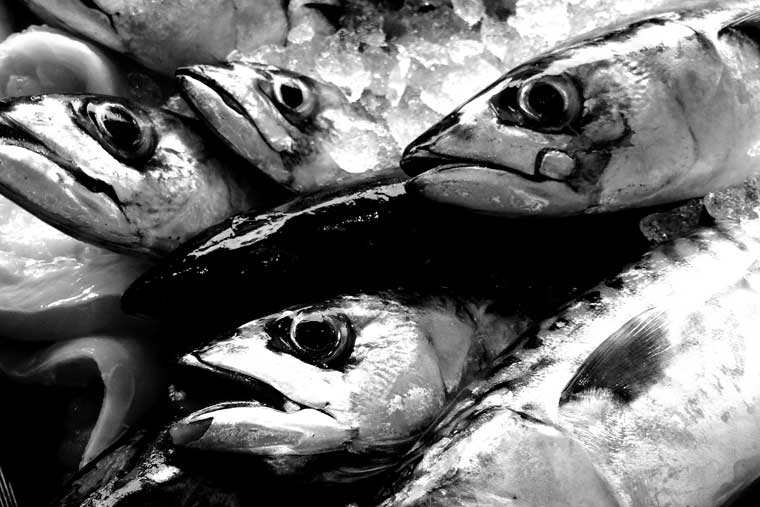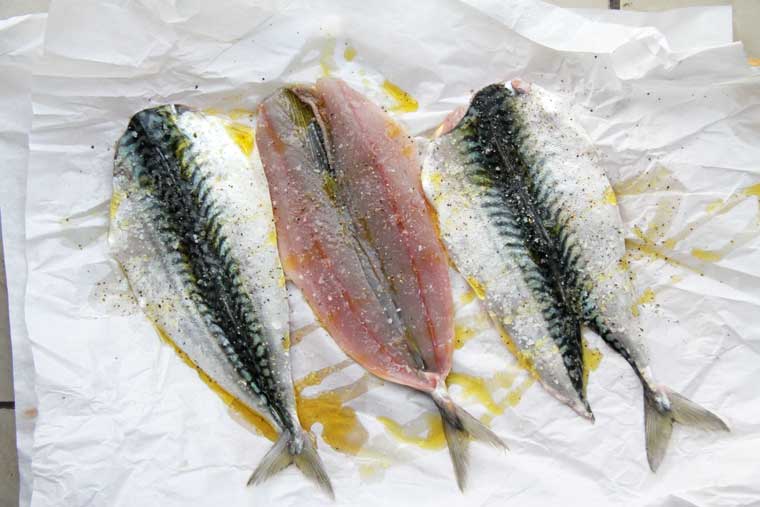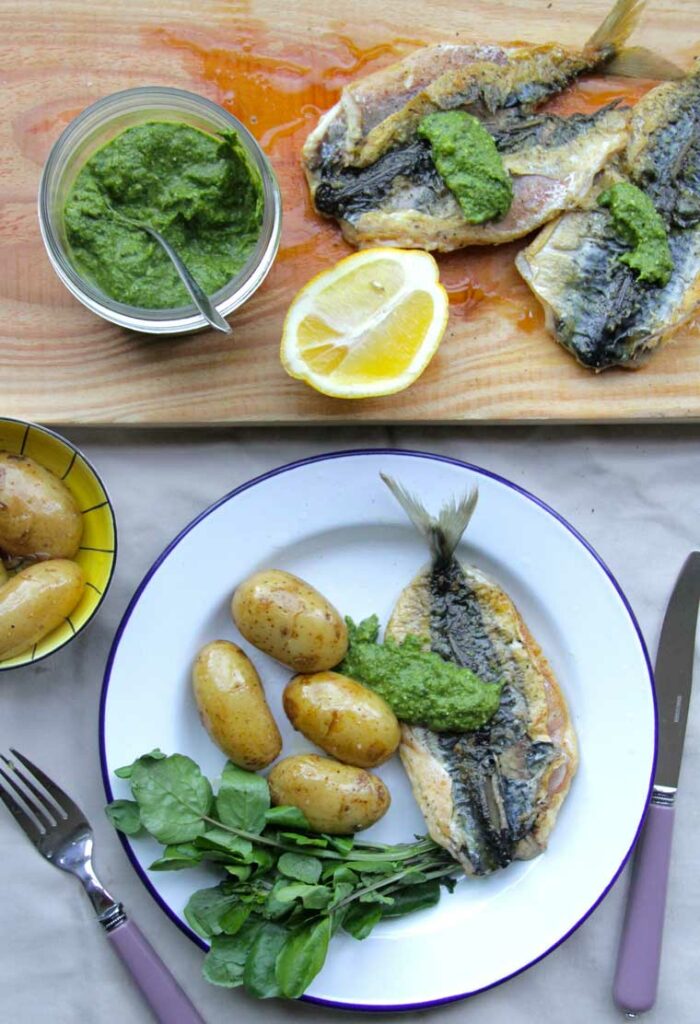August
Fish caught from the beach and chucked straight on to the BBQ, sardines blackened on a blistering grill, beans and berries bursting with flavour and butterflied mackerel with watercress pesto. Tom Hunt celebrates what we can enjoy this month.

After working so hard in spring to prepare our gardens, we’re now reaping the rewards. Beans, legumes, and berries pop up in ever increasing numbers. Gooseberries are prime right now, turning from sour little bullets into (slightly less sour!) delicious, tender berries. Bursting with flavour, they taste ever so good cooked up into a compote and mixed into a summer fool, or even char-grilled alongside little gem lettuce and served as a salad with crushed hazelnuts and smoked anchovies. Gooseberry sauces are also a great foil for my hero ingredient this month – mackerel – cutting its oily flesh perfectly.
Mackerel is a worthy hero in lots of ways: it’s affordable, sustainable and good for you too, being a particularly rich source of omega-3. A medium-size fish related to tuna, with similar agility, speed and fighting capabilities, it travels in shoals; so one day there can be none about, the next the sea can be boiling with them. (When they’re “in” like this by the shore, you can catch them by the bucket load from the beach.)
UK mackerel stocks are plentiful – indeed they are at their highest for 26 years, according to the latest survey by the International Council for the Exploration of the Seas (ICES) – so choose fish from our waters. They spawn between March and July, more or less, and although they can be abundant then, it is best to wait until August to make the most of this delicious summer delicacy.

Mackerel can live for up to 20 years and weigh over 3.5kg. A mature fish is over 28cm in length and the size available tends to reflect where they were caught: the minimum landing size for North Sea mackerel is 30cm, rather than 20cm elsewhere. I favour Cornish or other southern mackerel over the ones caught in Scottish waters, which tend not only to be larger, but also oilier and don’t seem to travel so well.
Like most fish, mackerel is at its best day-fresh: look for a bright patterned skin, clear eyes and fresh smell. The meat is firm, clean and pink, with a greyish tint. Also check the jaw: if it’s broken, it means the fish was line-caught, which typically carries a premium.
If you do manage to get hold of day-fresh mackerel, particularly if you’ve just caught it yourself, try eating it raw. It is surprisingly un-fishy and has a beautiful texture not dissimilar to toro (tuna belly), a highly revered Japanese delicacy with a melt-in-the-mouth texture. A recipe in my book The Natural Cook pairs mackerel sashimi with orange, chilli and tamari: a flavor combination that works particularly well, the orange awakening the palate and complimenting the mackerel’s fresh, saline flavour.
Sardines are another good choice this month as they too have finished spawning and are abundant. The Portuguese love them and sell them in most seaside restaurants, typically cooked on a char-grill, whole with the guts left in. Customers are left to drench the fish in lemon, devour the charred, rich, oily skin and flesh, working the meat from the carcass while avoiding the bitter innards which give the meat a richer, stronger flavour.
I have fond memories of Portugal, particularly Peniche, a fishing town north of Lisbon well known for its epic surf. Sleeping in my van, I’d breakfast on a gallo coffee, hot and milky with a pastel de natas or custard tart before embarking on a day’s surfing. In the evening I would reward myself by eating a dinner of hot sardines straight from the grill.
Sardines are currently on the menu at my restaurant Poco in Bristol served with a salsa quemada. Quemadatranslated literally means “burnt”, which refers to the cooking method: tomatoes, spring onions, chilli and garlic are blackened on a hot grill then blended together to make a chunky salsa with a lovely smokiness to it.

Butterflied mackerel with watercress pesto
Mackerel pairs well with this rather zesty watercress pesto: the pesto cuts through the omega-3 rich, oily flesh and brings the dish to life. Watercress is available most of the year and is an incredible source of nutrition: a genuine superfood. Cultivated in huge waterbeds mostly in Wiltshire, watercress is susceptible to pests so a lot of pesticides are used during cultivation. As with all leafy greens, these pesticides leave residues, so buy organic when possible, or wash well.
Ingredients
Serves 1
For the mackerel
1 small mackerel: ask your fishmonger to butterfly the mackerel
Lemon to serve
For the watercress pesto (makes 1 small jar)
2 tablespoons pine nuts
100g of watercress, washed, shaken dry and roughly chopped
30g parmesan
100ml of olive oil
Juice of half a lemon
To make the pesto
Toast the pine nuts in a dry pan for 3-5 minutes until they are golden brown with charred edges.
Put all ingredients in a blender. Season with salt and pepper and blend to a rough paste.
Store in a jar in the fridge for up to a week. Use any leftover pesto on pasta or as a salad dressing.
To cook the mackerel
Heat a griddle pan to a high temperature. Brush the mackerel fillets with olive oil and season with a little salt.
Place the fillets skin side down for about 3-4 minutes, until you see the skin start to turn golden and a little scorched in places. Flip the fillets over and sear for a further minute and no more.
Serve the fish with a good helping of watercress pesto and a squeeze of fresh lemon.
Tom Hunt is author of The Natural Cook: Eating the Seasons from Root to Fruit. He founded the Forgotten Feast, a campaign working on projects throughout the UK, to revive our cooking heritage and help reduce food waste and Poco, a festival café and award-winning restaurant in Bristol and (just opened) London’s Broadway Market. Click here to read his blog, Tom’s Feast.





